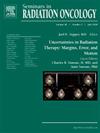辩论1:高危局限性前列腺癌:为什么激素联合放疗是大多数男性的最佳治疗策略
IF 3.2
3区 医学
Q3 ONCOLOGY
引用次数: 0
摘要
前列腺癌是美国男性中最常见的恶性肿瘤,高风险的局部疾病约占新病例的15%。高风险癌症预示着局部复发和远处转移的风险增加。尽管长期使用根治性前列腺切除术(RP)和决定性放疗(RT)联合雄激素剥夺疗法(ADT)作为主要治疗选择,但仍然缺乏直接比较这些方式的随机数据。正在进行的spg -15试验可能最终会提供这样的证据,但其结果预计要到2030年才能出来。在此期间,临床医生必须依靠现有的观察性研究来指导治疗选择。本综述综合了目前比较RP和RT+ADT治疗高危局限性前列腺癌的证据,强调了肿瘤预后、治疗相关的毒性和患者报告的生存期生活质量。RT+ADT可能在解决隐匿性微转移方面具有生物学优势,并具有放射生物学基础,可促进不同模式之间的协同作用。此外,尽管比较RP和RT+ADT的观察数据是异质的,而且通常在方法上是有限的,但最近使用现代因果推理框架的分析表明,RT+ADT改善了远处转移控制。不同治疗方式的毒性特征也有显著差异,RT+ADT的早期和长期泌尿系统副作用较少,治疗后悔较少,但治疗期间出现了短暂的激素相关症状和肠道症状。在这里,我们提出,在共享决策模型下,RT+ADT将成为大多数高危局限性前列腺癌男性的首选一线治疗方法,特别是随着现代放疗技术的进步,在保持生活质量的同时提供良好的肿瘤控制。本文章由计算机程序翻译,如有差异,请以英文原文为准。
Debate 1: High-Risk Localized Prostate Cancer: Why Combination Hormone Therapy and Radiotherapy is the Optimal Treatment Strategy for Most Men
Prostate cancer is the most commonly diagnosed malignancy among men in the United States, with high-risk localized disease accounting for approximately 15% of new cases. High-risk cancer portends increased risk of locoregional recurrence and distant metastases. Despite the longstanding use of radical prostatectomy (RP) and definitive radiotherapy (RT) with androgen deprivation therapy (ADT) as primary treatment options, there remains a lack of randomized data directly comparing these modalities. The ongoing SPCG-15 trial may eventually provide such evidence but its results are not expected until 2030. In the interim, clinicians must rely on existing observational studies to guide treatment selection. This review synthesizes current evidence comparing RP and RT+ADT for high-risk localized prostate cancer, highlighting oncologic outcomes, treatment-related toxicities, and patient-reported quality of life in survivorship. RT+ADT may offer biological advantages in addressing occult micrometastases with radiobiological foundations for synergy between modalities. Further, although observational data comparing RP and RT+ADT are heterogeneous and often methodologically limited, recent analyses using modern causal inference frameworks suggest improved distant metastatic control with RT+ADT. Toxicity profiles also differ significantly between modalities, with RT+ADT associated with fewer early and long-term urinary side effects, and less treatment regret but transient hormone-related and bowel symptoms during treatment. Here, we propose that under the shared-decision-making model RT+ADT will be the preferred first-line treatment for most men with high-risk localized prostate cancer, offering favorable oncologic control while preserving quality of life, particularly with modern advances in radiotherapy techniques.
求助全文
通过发布文献求助,成功后即可免费获取论文全文。
去求助
来源期刊
CiteScore
5.80
自引率
0.00%
发文量
48
审稿时长
>12 weeks
期刊介绍:
Each issue of Seminars in Radiation Oncology is compiled by a guest editor to address a specific topic in the specialty, presenting definitive information on areas of rapid change and development. A significant number of articles report new scientific information. Topics covered include tumor biology, diagnosis, medical and surgical management of the patient, and new technologies.

 求助内容:
求助内容: 应助结果提醒方式:
应助结果提醒方式:


